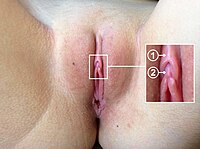
Photo from wikipedia
Background Penile fracture (PF) is defined as rupture of the tunica albuginea of the corpora cavernosa. While most authors agree that rapid surgical therapy of this rare pathology leads to… Click to show full abstract
Background Penile fracture (PF) is defined as rupture of the tunica albuginea of the corpora cavernosa. While most authors agree that rapid surgical therapy of this rare pathology leads to the best patient outcome, the role of imaging is highly controversial in the published literature. To obtain further evidence concerning the diagnostic accuracies of magnetic resonance imaging (MRI) and ultrasound (US) in the diagnostic assessment of patients with suspected PF. Methods We systematically reviewed MRI and US examinations performed in our institution between 2000 and 2021 and correlated imaging reports with either intraoperative finding or final clinical diagnosis. Inclusion criteria were: (I) patient age ≥18 years, (II) examination between 2000 and 2021, (III) information available on patient's history and clinical presentation, and (IV) documented final diagnosis in discharge letter. Next to diagnostic accuracy, we describe typical imaging findings such as penile hematoma, tear of the tunica albuginea including location in terms of side and shaft segment affected, and involvement of corpus spongiosum. Results Overall, 46 of 88 included patients (54.5%) had a confirmed diagnosis of PF. A total of 69 MRI and 31 US examinations were included. Sensitivity and specificity were 91.9% (95% CI: 78.7-97.2%) and 90.6% (95% CI: 75.8-96.8%) for MRI and 71.4% (95% CI: 45.4-88.3%) and 100.0% (95% CI: 81.6-100.0%) for US, respectively. Conclusions The results of the present study suggest that MRI is more suitable to confirm PF and identify the site of the associated tunica albuginea tear while US is a good tool for ruling out PF.
Journal Title: Translational andrology and urology
Year Published: 2022
Link to full text (if available)
Share on Social Media: Sign Up to like & get
recommendations!